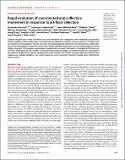Files in this item
Rapid evolution of coordinated and collective movement in response to artificial selection
Item metadata
| dc.contributor.author | Kotrschal, Alexander | |
| dc.contributor.author | Szorkovszky, Alexander | |
| dc.contributor.author | Herbert-Read, James | |
| dc.contributor.author | Bloch, Natasha I. | |
| dc.contributor.author | Romenskyy, Maksym | |
| dc.contributor.author | Buechel, Séverine Denise | |
| dc.contributor.author | Eslava, Ada Fontrodona | |
| dc.contributor.author | Alòs, Laura Sánchez | |
| dc.contributor.author | Zeng, Hongli | |
| dc.contributor.author | Le Foll, Audrey | |
| dc.contributor.author | Braux, Ganaël | |
| dc.contributor.author | Pelckmans, Kristiaan | |
| dc.contributor.author | Mank, Judith E. | |
| dc.contributor.author | Sumpter, David | |
| dc.contributor.author | Kolm, Niclas | |
| dc.date.accessioned | 2020-12-16T16:30:23Z | |
| dc.date.available | 2020-12-16T16:30:23Z | |
| dc.date.issued | 2020-12-02 | |
| dc.identifier | 271709252 | |
| dc.identifier | 1f3f5eac-52b2-41db-b0a6-5d62d5192237 | |
| dc.identifier | 85097121032 | |
| dc.identifier | 33268362 | |
| dc.identifier | 000596477400001 | |
| dc.identifier.citation | Kotrschal , A , Szorkovszky , A , Herbert-Read , J , Bloch , N I , Romenskyy , M , Buechel , S D , Eslava , A F , Alòs , L S , Zeng , H , Le Foll , A , Braux , G , Pelckmans , K , Mank , J E , Sumpter , D & Kolm , N 2020 , ' Rapid evolution of coordinated and collective movement in response to artificial selection ' , Science Advances , vol. 6 , no. 49 , eaba3148 . https://doi.org/10.1126/sciadv.aba3148 | en |
| dc.identifier.issn | 2375-2548 | |
| dc.identifier.uri | https://hdl.handle.net/10023/21166 | |
| dc.description | Funding: This work was supported by the Knut and Alice Wallenberg Foundation (102 2013.0072 to D.S., N.K., and K.P.), the Swedish Research Council (2016-03435 to N.K., 2017-04957 to A.K., and 2018-04076 to J.H.-R.), and the Whitten Lectureship in Marine Biology, University of Cambridge (to J.H.-R.). | en |
| dc.description.abstract | Collective motion occurs when individuals use social interaction rules to respond to the movements and positions of their neighbors. How readily these social decisions are shaped by selection remains unknown. Through artificial selection on fish (guppies, Poecilia reticulata) for increased group polarization, we demonstrate rapid evolution in how individuals use social interaction rules. Within only three generations, groups of polarization-selected females showed a 15% increase in polarization, coupled with increased cohesiveness, compared to fish from control lines. Although lines did not differ in their physical swimming ability or exploratory behavior, polarization-selected fish adopted faster speeds, particularly in social contexts, and showed stronger alignment and attraction responses to multiple neighbors. Our results reveal the social interaction rules that change when collective behavior evolves. | |
| dc.format.extent | 7 | |
| dc.format.extent | 875473 | |
| dc.language.iso | eng | |
| dc.relation.ispartof | Science Advances | en |
| dc.subject | QH301 Biology | en |
| dc.subject | DAS | en |
| dc.subject.lcc | QH301 | en |
| dc.title | Rapid evolution of coordinated and collective movement in response to artificial selection | en |
| dc.type | Journal article | en |
| dc.contributor.institution | University of St Andrews. Centre for Biological Diversity | en |
| dc.contributor.institution | University of St Andrews. School of Biology | en |
| dc.identifier.doi | https://doi.org/10.1126/sciadv.aba3148 | |
| dc.description.status | Peer reviewed | en |
This item appears in the following Collection(s)
Items in the St Andrews Research Repository are protected by copyright, with all rights reserved, unless otherwise indicated.

